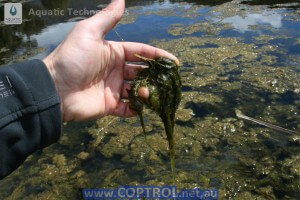How to Control Algae in Turf Farms
Algae can cause real problems in turf farms
Algae can block essential nutrients on irrigated farms
Algae cause chronic problems
|
Algal scum can cause chronic problems on turfs, especially those with poor air circulation, compacted soils and wet areas. Algal growth is encouraged by extended periods of rainy, overcast and warm weather. Algal scums slow water infiltration, keep thatch wet for extended periods, and impede oxygen and other gas diffusion into and out of soils.
|
COPTROL is a highly effective and proven method for eliminating filamentous and other forms of algae.|coptrol filamentous |
| If algae is a problem in your turf or in your water source follow this 5 step method to keep your waters clear and bright.
1. First identify the algae present. Please use our guide here for more information. This page explains common algae within Australia. 2. Now calculate the volume of water to treat. Ignore depths below 1 metre. Please refer to our “Quantities” page to calculate the amount of water to treat. 3. Next calculate the amount of Coptrol needed. An easy way to calculate is: • If the algae is fine and free floating use 2 mL of Coptrol per 1000 Litres (1 cubic metre) of water. That is equivalent to 2 Litres of Coptrol per 1000 square metres of surface area. • If the algae is long and stringy use 5 mL per 1000 litres of water (1 cubic metre) or 5 Litres per 1000 square metres of surface area. 4. Dilute the required amount of Coptrol using a 1:10 or even a 1:20 Coptrol water dilution. 5. The best application method is by spraying. Apply on a sunlit wind free day when algae first appear. If this is impractical, please refer to our “Application” page on how to apply Coptrol. |



